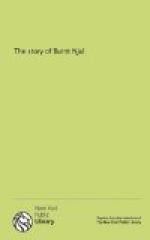[Footnote 4: There can be no doubt that it was considered a grave offence to public morality to tell a Saga untruthfully. Respect to friends and enemies alike, when they were dead and gone, demanded that the histories of their lives, and especially of their last moments, should be told as the events had actually happened. Our own Saga affords a good illustration of this, and shows at the same time how a Saga naturally arose out of great events. When King Sigtrygg was Earl Sigurd’s guest at Yule, and Flosi and the other Burners were about the Earl’s court, the Irish king wished to hear the story of the Burning, and Gunnar Lambi’s son was put forward to tell it at the feast on Christmas day. It only added to Kari’s grudge against him to hear Gunnar tell the story with such a false leaning, when he gave it out that Skarphedinn had wept for fear of the fire, and the vengeance which so speedily overtook the false teller was looked upon as just retribution. But when Flosi took up the story, he told it fairly and justly for both sides, “and therefore,” says the Saga, “what he said was believed".]
[Footnote 5: Oeresound, the gut between Denmark and Sweden, at the entrance of the Baltic, commonly called in English, The Sound.]
[Footnote 6: That is, he came from what we call the Western Isles or Hebrides. The old appellation still lingers in “Sodor (i.e. the South isles) and Man".]
[Footnote 7: This means that Njal was one of those gifted beings who, according to the firm belief of that age, had a more than human insight into things about to happen. It answers very nearly to the Scottish “second sight".]
[Footnote 8: Lord of rings, a periphrasis for a chief, that is, Mord.]
[Footnote 9: Earth’s offspring, a periphrasis for woman, that is, Unna.]
[Footnote 10: “Oyce,” a north country word for the mouth of a river, from the Icelandic os]
[Footnote 11: “The Bay,” the name given to the great bay in the east of Norway, the entrance of which from the North Sea is the Cattegat, and at the end of which is the Christiania Firth. The name also applies to the land round the Bay, which thus formed a district, the boundary of which, on the one side, was the promontory called Lindesnaes, or the Naze, and on the other, the Goeta-Elf, the river on which the Swedish town of Gottenburg stands, and off the mouth of which lies the island of Hisingen, mentioned shortly after.]
[Footnote 12: Permia, the country one comes to after doubling the North Cape.]
[Footnote 13: A town at the mouth of the Christiania Firth. It was a great place for traffic in early times, and was long the only mart in the south-east of Norway.]
[Footnote 14: Rill of wolf—stream of blood.]
[Footnote 15: A province of Sweden.]
[Footnote 16: An island in the Baltic, off the coast of Esthonia.]
[Footnote 17: Endil’s courser—periphrasis for a ship.]




